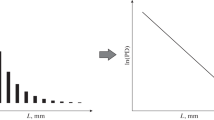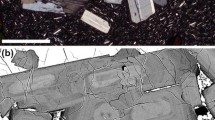Abstract
The distributions of illite crystal (‘fundamental particle’) thickness in <0.2 µm fractions of 13 shale samples (from the Carpathian Foredeep, Poland), obtained using the Bertaut-Warren-Averbach X-ray diffraction method (MudMaster computer program), were analyzed and interpreted in terms of the mechanism of smectite illitization. All illite crystal thickness distributions in the analyzed shales are characterized by an ‘asymptotic’ shape. The origin of the asymptotic-type distributions is explained by the heterogeneity of illite crystals in shales, i.e. superposition of different populations of crystals, those included in illite-smectite (I-S) interstratifications, and those which occur as discrete illite. The analysis of the distributions in shales shows that the most frequent thickness class of illite crystals forming I-S is 2 nm. Discrete illite is composed of thicker crystals; though crystals as thin as 2 nm can also contribute to this population. The modeling of asymptotic distributions in shales by using a number of theoretical lognormal distributions shows that with progressive diagenesis, the mean thickness of illite crystals forming the I-S component increases gradually, whereas the discrete illite does not show a clear trend.
The diverse origins of illite crystals in shales do not permit determination of the mechanism of smectite illitization from the evolution of the shape of the overall crystal-thickness distribution during diagenesis. Therefore, in order to understand the mechanism of smectite illitization in shales, an attempt was made to trace the relative gains and losses of crystals of different thicknesses during illitization. This approach indicates the following mechanism of smectite illitization in the investigated shales: dissolution of smectite monolayers accompanied by growth of 2 nm crystals which are largely of detrital origin. Nucleation of 2 nm illites seems to be very limited.
Similar content being viewed by others
References
Brime, C. and Eberl, D.D. (2002) Growth mechanism of low-grade illites based on shapes of crystal thickness distributions. Schweizerisches Mineralogisches und Petrogrographisches Mitteilungen, 82, 203–209.
Brime, C., Castro, M. and Valin, M.L. (2002) Recognizing illitization progress from diagenesis to very low-grade metamorphism in rocks of the Cantabrian Zone (Spain). Schweizerisches Mineralogisches und Petrogrographisches Mitteilungen, 82, 211–219.
Burkhard, D. (2002) Kinetics of crystallization: example of micro-crystallization in basalt lava. Contributions to Mineralogy and Petrology, 142, 724–737.
Christidis, G.E. (1995) Mechanism of illitization of bentonites in the geothermal field of Milos Island, Greece: Evidence based on mineralogy, chemistry, particle thickness morphology. Clays and Clay Minerals, 43, 569–586.
Clauer, N., Środoń, J., Francù, J. and Šucha, V. (1997) K-Ar dating of illite fundamental particles separated from illitesmectite. Clay Minerals, 32, 181–196.
Drits, V., Salyn, A.L. and Šucha, V. (1996) Structural transformations of interstratified illite/smectites from Dolna Ves hydrothermal deposits: dynamics and mechanisms. Clays and Clay Minerals, 44, 181–190.
Drits, V., Eberl, D.D. and Środoń, J. (1998) XRD measurement of mean thickness, thickness distribution and strain for illite and illite-smectite crystallites by the Bertaut-Warren-Averbach technique. Clays and Clay Minerals, 46, 38–50.
Dudek, T. (2001) Diagenetic evolution of illite-smectite in the Miocene shales from the Przemyśl area (Carpathian Foredeep). PhD thesis, Institute of Geological Sciences, Polish Academy of Sciences, 155 pp.
Dudek, T., Środoń, J., Eberl, D.D., Elsass, F. and Uhlik, P. (2002) Thickness distribution of illite crystals in shales. I: X-ray diffraction vs. high-resolution transmission electron microscopy measurements. Clays and Clay Minerals, 50, 562–577.
Eberl, D.D. and Środoń, J. (1988) Ostwald ripening and interparticle diffraction effects for illite crystals. American Mineralogist, 73, 1335–1345.
Eberl, D.D., Środoń, J., Kralik, M., Taylor, B.E. and Peterman, Z.E. (1990) Ostwald ripening of clays and metamorphic minerals. Science, 248, 474–478.
Eberl, D.D., Drits, V. and Środoń, J. (1998a) Deducing growth mechanisms for minerals from the shapes of crystal size distributions. American Journal of Science, 298, 499–533.
Eberl, D.D., Nuesch, R., Šucha, V. and Tsipursky, S. (1998b) Measurement of fundamental illite particle thicknesses by X-ray diffraction using PVP-10 intercalation. Clays and Clay Minerals, 46, 89 — 97.
Elsass, F., Środoń, J. and Robert, M. (1997) Illite-smectite alteration and accompanying reactions in a Pennsylvanian underclay studied by TEM. Clays and Clay Minerals, 45, 390–403.
Higgins, M.D. (2002) A crystal-size distribution study of the Kiglapait layered mafic intrusion, Labrador, Canada: evidence for textural coarsening. Contributions to Mineralogy and Petrology, 144, 314–330.
Inoue, A. and Kitagawa, R. (1994) Morphological characteristics of illitic clay minerals from a hydrothermal system. American Mineralogist, 79, 700–711.
Inoue, A., Velde, B., Meunier, A. and Touchard, G. (1988) Mechanism of illite formation during smectite-to-illite conversion in a hydrothermal system. American Mineralogist, 73, 1325–1334.
Kile, D.E., Eberl, D.D., Hoch, A.R. and Reddy, M.M. (2000) An assessment of calcite crystal growth mechanism based on crystal size distributions. Geochimica et Cosmochimica Acta, 64, 2937–2950.
Kirkpatrick, R.J. (1981) Kinetics of crystallization of igneous rocks. Pp. 321–398 in: Kinetics ofGeochemical Processes (A.C. Lasaga and R.J. Kirkpatrick, editors). Reviews in Mineralogy, 8. Mineralogical Society of America, Washington, D.C.
Marsh, B.D. (1988) Crystal size distribution (CSD) in rocks and the kinetics and dynamics of crystallization I. Theory. Contributions to Mineralogy and Petrology, 99, 277–291.
Nadeau, P.H., Tait, J.M., McHardy, W.J. and Wilson, M.J. (1984a) Interstratified XRD characteristics of physical mixtures of elementary clay particles. Clay Minerals, 19, 67–76.
Nadeau, P.H., Wilson, M.J., McHardy, W.J. and Tait, J.M. (1984b) Interparticle diffraction: a new concept for inter-stratified clays. Clay Minerals, 19, 757–769.
Nadeau, P.H., Wilson, M.J., McHardy, W.J. and Tait, J.M. (1985) The conversion of smectite to illite during diagenesis: evidence from some illitic clays from bentonites and sandstones. Mineralogical Magazine, 49, 393–400.
Reynolds, R.C. Jr. (1992) X-ray diffraction studies of illite/smectite from rocks, <1 µm randomly oriented powders, and <1 µm oriented powder aggregates: the absence of laboratory-induced artifacts. Clays and Clay Minerals, 40, 387–396.
Środoń, J. (1981) X-ray identification of randomly interstratified illite/smectite in mixtures with discrete illite. Clay Minerals 16, 297–304.
Środoń, J. (1984) X-ray powder diffraction identification of illitic materials. Clays and Clay Minerals, 32, 337–349.
Środoń, J., Andreoli, C., Elsass, F. and Robert, M. (1990) Direct high-resolution transmission electron microscopic measurements of expandability of mixed-layer illite/smectite in bentonite rock. Clays and Clay Minerals, 38, 373–379.
Środoń, J., Eberl, D.D. and Drits, V. (2000) Evolution of fundamental particle size during illitization of smectite and implications for the illitization mechanism. Clays and Clay Minerals, 48, 446–459.
Środoń, J., Elsass, F., McHardy, W.J. and Morgan, D.J. (1992) Chemistry of illite-smectite inferred from TEM measurements of fundamental particles. Clay Minerals, 27, 137–158.
Šucha, V., Kraus, I., Gerthofferová, H., Petes, J. and Sereková, M. (1993) Smectite to illite conversion in bentonites and shales of the East Slovak Basin. Clay Minerals, 28, 243–253.
Uhlik, P., Šucha, V., Elsass, F. and Čaplovičová, M. (2000) High-resolution transmission electron microscopy of mixed-layer clays dispersed in PVP-10: A new technique to distinguish detrital and authigenic illitic material. Clay Minerals, 35, 781–789.
Author information
Authors and Affiliations
Corresponding author
Rights and permissions
About this article
Cite this article
Dudek, T., Środoń, J. Thickness Distribution of Illite Crystals in Shales. II: Origin of the Distribution and the Mechanism of Smectite Illitization in Shales. Clays Clay Miner. 51, 529–542 (2003). https://doi.org/10.1346/CCMN.2003.0510507
Received:
Revised:
Published:
Issue Date:
DOI: https://doi.org/10.1346/CCMN.2003.0510507




